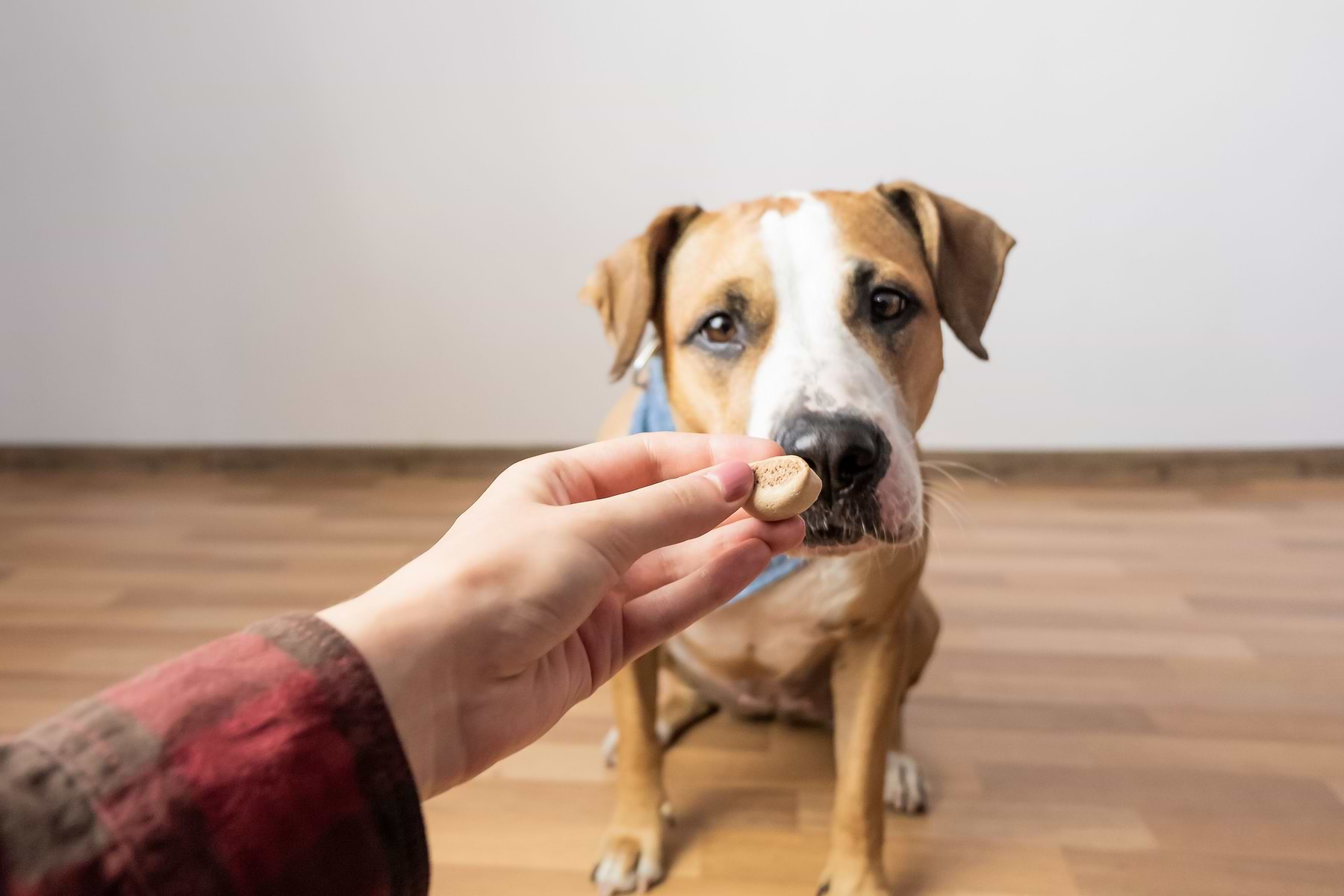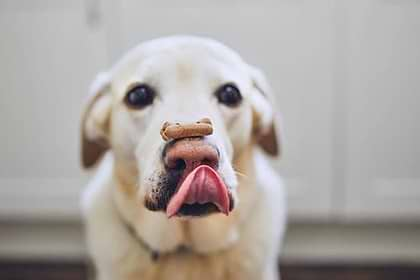Positive reinforcement training is an effective way to train your dog. As with other obedience training methods, it takes consistency, practice, and a thorough understanding of how it works. With time and patience, your dog will be able to repeat new behaviors and tricks through the use of positive reinforcement training. Read on to learn more!
What Is Positive Reinforcement Training?
As compared to negative reinforcement, positive reinforcement training is the practice of using an immediate reward for a certain desirable behavior with the hopes that the subject (your dog) will repeat that behavior again and again.
For example, if you ask your pup to sit, and they do, the positive reinforcement is to immediately give them a treat, verbal praise, a pat, or a toy. The next time you ask your dog to sit, they will, knowing that they will get a reward or some form of enrichment for obeying the command.
To break it down even more, your dog’s behavior is being reinforced by something that, through your dog’s eyes, is desired. The positive reward could be a treat, verbal praise, physical touch (like petting), or playtime. When you, the trainer, reward your pup for good behavior, they’re more likely to repeat said behavior as your dog innately wants to please you.
When To Use It
Use positive training methods when you want your pup to learn something, like a basic command or something more extensive, like agility. You can use it when you want to teach your dog certain cues, or when you want to reinforce good behavior.
For instance, if your dog jumps a lot and you want them to stop, you can use positive reinforcement to teach them that their paws should stay on the ground. Use positive reinforcement after saying “Down!” and only when your dog actually gets back down onto the floor.
You’re essentially associating positivity with the behaviors that you like, and ignoring the behavior problems you don’t like. Punishment, whether negative punishment or positive punishment, isn’t part of the process.
Types of Rewards
There are various types of rewards you can use when implementing positive reinforcement. Some rewards will be more effective than others, but any of the below should suffice. If you notice that one type of reward isn’t working as well as you’d like it to, try switching to a different kind of reward, maybe one that’s considered premium to your pet.
Treats
Using food treats, like dog biscuits, as a reward is a great way to positively reinforce good behavior. Treats are usually the most effective because most dogs are food motivated.
Experiment with a few different types of treats. Some dogs will obey with something as simple as a piece of kibble. Pickier dogs might look for something more enticing and irresistible, like a piece of chicken. Here are some treat options for your good pup:
- Kibble
- Cooked chicken or beef
- Carrots
- Cheese
Check in with your vet if you’re unsure whether your dog can have a certain food item.
Praise
Praise works as a form of positive reinforcement too. Even if you are using treats to teach your dog to behave, you should still pair them with verbal praise. This could be as simple as “yes”, “good boy/girl”, or something similar.
Get in the habit of saying “yes” when your dog does something good, like going to the bathroom on the potty pad, or heading to their crate when asked. Over time, your dog will begin to associate certain words with good behavior. Don’t forget to keep your tone of voice lighthearted and enthusiastic.
Physical Touch
Positive reinforcement also includes petting or physical touch. Scratch your buddy behind the ears, or pat them on the head. Give them kisses on the snout or a little rub under the chin. Petting is a good way to bond with your pet and positively reinforce great behavior.
Play or Toys
Give your pup a toy as a way to say, well done! Toys or playtime is a good way to positively reinforce as well. Try withholding desirable toys from your dog until a moment of positive reinforcement. By withholding toys and play sessions until training time, your dog will likely be more motivated for these rewards and will learn that certain behaviors are followed by their favorite chews.
Timing
With positive reinforcement, timing is everything. That, and consistency, which is highlighted below. Reinforcement must immediately follow the behavior. If you delay, your pet might’ve already moved on to another behavior. They’ll be confused as to what behavior they’re being rewarded for.
It’s important to note the frequency of your positive reinforcement. When a pup is first learning, continuous reinforcement works well. This means that each and every time the dog performs a behavior, they are rewarded with either a treat, praise, a pat, or a toy.
As your dog starts to catch onto what is right and what is wrong, it is more effective to use intermittent reinforcement, which is the rewarding of good behavior every two or three times your pet performs. Good behavior tends to be stronger and last longer if done this way.
Keep It Consistent
As usual, consistency is key. Training your pup is a continuous process and requires patience and persistence. Make sure you are consistently rewarding your desired behavior and not acknowledging undesired behavior. It will be a step-by-step process, but you’ll be happier in the end when your canine companion is well-behaved and has stopped engaging in bad behavior.
All Hands on Deck
It’s important to make sure everyone in your household is on the same page in regards to the positive methods of training. All members need to know what behaviors are considered good and what behaviors are considered bad.
For example, if the dog is not supposed to be on the couch, all household members need to use positive reinforcement training to keep the dog off the couch. If your children are occasionally allowing them on the couch, then they will become confused and the positive reinforcement training will not work.
Crate Training
Incorporate crate training into your positive reinforcement training sessions. Crate training is known to make a dog feel more secure and safe. Crates, when used correctly, have the potential to become your pup’s safe haven. It’s a little den for your furry friend. It’s a snug home within a home. Crate training gives dogs a sense of security and safety and helps give dog owners greater peace of mind.
Investing in a durable, well-built crate for your pup is a good place to start. It should be big enough for your pet to stand up and turn around. Incorporate a crate training aid that will assist with positive reinforcement and association, and make their space as comfortable as possible. You can do this by dressing the crate with a blanket or an orthopedic crate pad. Using treats and their favorite chews is another way to teach them that the crate is a great place to be.
Common Mistakes
There are a handful of mistakes pet parents make when attempting to train via positive reinforcement.
While dogs can be trained at any age, it’s good to start training them as soon as they enter your home. A common mistake made by pet owners is that they wait too long to begin the process of positive reinforcement. Don’t give your dog too much time to develop bad habits, like chewing, digging, or aggression towards visitors.
Inconsistency is another common mistake. Consistent responses are essential to dog training, no matter what kind of training it is. Stay consistent. Make sure all of your household members are on the same page.
Enforcing a “no couch” rule but occasionally letting your dog snooze on the couch is not consistent. Similarly, teaching your dog not to beg and then occasionally giving them a piece of your dinner is going to lead to confusion, as it’s inconsistent.
Harsh discipline is another common mistake made by pet parents. Punishing your dog, using physical force, or making them fearful of you is not effective. In general, dogs are going to perform better via positive enforcement training and rewards rather than harsh punishments. A pet parent needs to earn their dominance and the dog’s respect.
Lastly, a lack of patience will lead to inconsistent training and frustration from the pet and the pet parent. Be patient. All dogs learn at a different pace. Getting stressed out or frustrated with your companion will leave them feeling stressed out and frustrated, and no progress will be made. Keep training sessions short and sweet albeit consistent to avoid dog boredom or anxiety. Don’t expect your dog to last hours and hours on one command.
Summary
To conclude, positive reinforcement should all in all be a good experience for both the pet and the pet handler. Consider what you want your dog to learn and go from there. Take a moment to think about all of the different types of rewards that you can provide to your dog via positive reinforcement training.
What is best received? Is it treats? Praise? Pets? Toys? If you keep your training consistent and get all of your family members on board, you’ll be left with a well-behaved and confident dog.
Sources:
Positive reinforcement training | Humane Society
Positive Rewards Dog Training Tips | American Kennel Club
What is Positive Reinforcement in Dog Training? | Companion Animal Psychology
Positive Reinforcement: Training with treats and praise | HSHV
Using Reinforcement and Rewards to Train Your Pet | VCA Hospitals

The Diggs Team
We believe our dogs deserve safer, better designed pet products.
You might also like
Crate training tips, stories and inspiration
View all blogsIn Your Diggs
Share your photos with #DiggsPet and tag us @DiggsPet on IG and TikTok.



